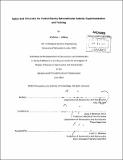Space suit simulator for partial gravity extravehicular activity experimentation and training
Author(s)
Gilkey, Andrea L. (Andrea Lynn)
DownloadFull printable version (18.61Mb)
Alternative title
3S for partial gravity extravehicular activity experimentation and training
Other Contributors
Massachusetts Institute of Technology. Dept. of Aeronautics and Astronautics.
Advisor
Dava J Newman.
Terms of use
Metadata
Show full item recordAbstract
During human space exploration, mobility is extremely limited when working inside a pressurized space suit. Astronauts perform extensive training on Earth to become accustomed to space suit-imposed high joint torques and limited range of motion. Space suit experimentation is difficult for researchers because the current suit is expensive, bulky, heavy, hard to don/doff, and in very short supply. The main objective of this thesis is to develop a wearable space suit simulator (S3) exoskeleton that can mimic the joint torques and reduced mobility of various pressurized space suit designs. A space suit simulator exoskeleton is a novel method for simulating joint torques while offering a lightweight, portable, and easily accessible design. This thesis describes early work towards development of the S3 exoskeleton. A space suit joint database was developed, which includes joint torque and angle range of motion information for multiple pressurized space suits, degrees of freedom, and pressurization levels. The space suit joint database was used to set the joint torque and angle range of motion requirements for the S3 exoskeleton. Additionally, various actuators that have been used in previous exoskeleton designs were compared according to weight and bulk characteristics to select actuators for the S3 exoskeleton. The conceptual designs of the S3 knee and hip components are presented. Finally, the S3 computer simulation is described, which allows users to input the geometries and locations of the S3 exoskeleton components. The computer simulation outputs the space suit hysteresis curves to compare S3 joint design performance to actual space suit performance. Feasible design solutions for the S3 exoskeleton joints can be determined from designs that minimize the root-mean-square error of the hysteresis curves.
Description
Thesis (S.M.)--Massachusetts Institute of Technology, Dept. of Aeronautics and Astronautics, 2012. Cataloged from PDF version of thesis. Includes bibliographical references (p. 103-105).
Date issued
2012Department
Massachusetts Institute of Technology. Department of Aeronautics and AstronauticsPublisher
Massachusetts Institute of Technology
Keywords
Aeronautics and Astronautics.